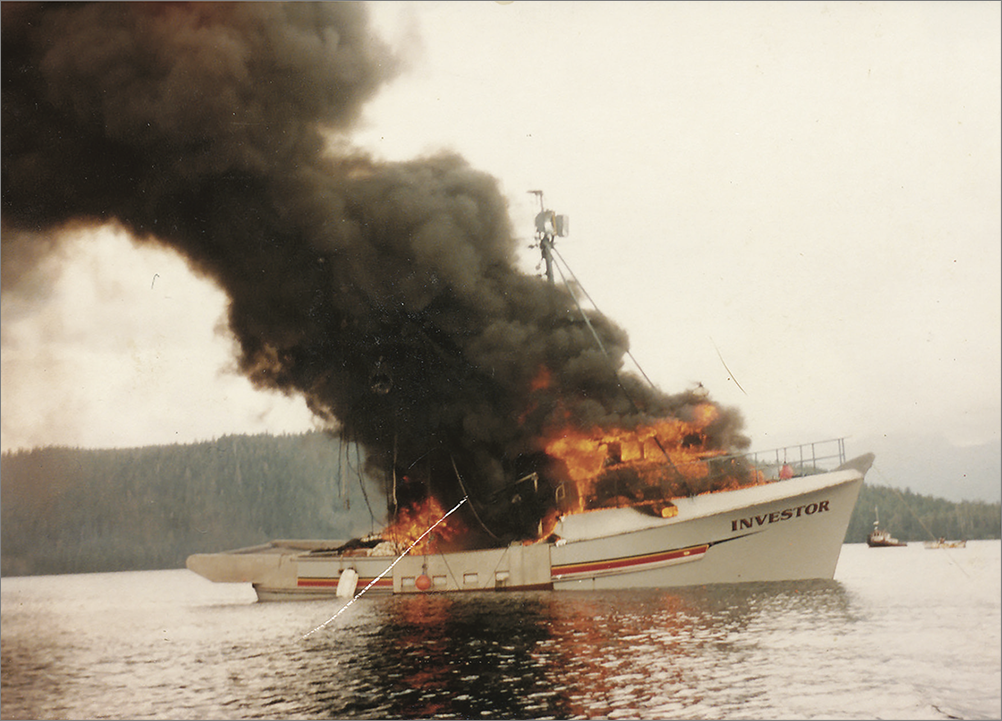Barker Davie had extensively analyzed the Investor fire. A former forensic chemist for the Fort Wayne Police Department from 1973-1980, he was one of the top arson investigators in the United States and Canada. According to Davie, this was an arson fire designed to cover-up the murders.
It was telling, he averred, that two to five gallons of an accelerant were found on multiple places aboard the vessel. Somewhat surprisingly, white gas was prominent among those samples. The fire itself, meanwhile, had burned at temperatures approaching 2,400 degrees Fahrenheit.
Those were temperatures hot enough to destroy John Coulthurst’s body.

None of these things, either by themselves or together, put John Peel on the Investor with a jerry jug of flammable liquid. So the prosecution asked whether Davie believed another accelerant could have been present. An accelerant like regular gas. It was a crucial question, because the only gas station in town sold gasoline — but not white gas.
“My answer to that would be that, based on my observations, it’s equally possible that other types of materials could have been present,” Davie replied, sounding like the cautious scientist he was. “I can only state that I did find white gas in samples submitted to me. But it does not exclude the possibility of other accelerants being present.”
When cross-examination began, defense attorney Phillip Weidner’s attack went to the arson investigator’s competence. He noted with particular mirth a recent fire investigation where Davie had changed his mind. His initial assessment, the attorney pointed out, was that the “fire was caused by spontaneous combustion.”
“Did you later give a sworn affidavit to the effect that your initial opinion was wrong and that you then believed that the fire was of incendiary origin?” Weidner asked slyly.
“Yes, I did,” Davie answered without emotion. In his world, it was better to be wrong and admit it than to be wrong and deny it.
That was not the case in Weidner’s world. The defense attorney quickly pivoted. He questioned Davie’s contention that the fire thoroughly consumed Johnny Coulthurst. He read from an article entitled, “Is It Possible to Consume a Body Completely in a Fire,” by William Bass.
‘The answer is no,” Weidner intoned, reading the article from a textbook. ”Even though no soft tissue may remain, there are always pieces of the skeleton, and if a careful search is made by well-trained osteologists, fragments of bones can be recovered and subsequently identified.”

But the arson expert had an article of his own to quote. Reading from a book on forensic dentistry, Davie noted that infant bodies may be completely destroyed in conditions such as the Investor. The vessel had all the characteristics of a crematorium. That wasn’t the only indignity. Firefighting efforts poured a deluge of water onto her. Once extingished, she was at the whims of the tide. The totality suggested a grim reality.
Johnny Coulthurst’s remains were lost at sea.
This one, as the lawyers would say, was for the jury to decide. Still, one was left to ponder Weidner’s overarching point. Was he suggesting that the fire wasn’t purposefully set? That it wasn’t a cover-up? No. Not that. He was attacking the State’s case by attacking the competence of its experts. Even when the experts were right, the jury had to think they were wrong. He was playing the long game.
Excerpts from the unpublished original manuscript, “Sailor Take Warning,” by Leland E. Hale. That manuscript, started in 1992 and based on court records from the Alaska State Archive, served as the basis for “What Happened in Craig.”
Copyright Leland E. Hale (2020). All rights reserved.

Order “What Happened In Craig,” HERE and HERE. True crime from Epicenter Press.